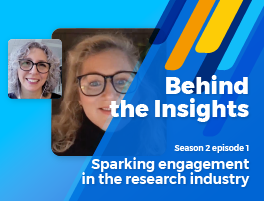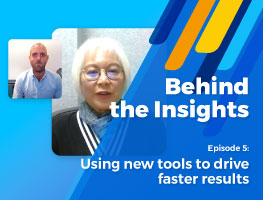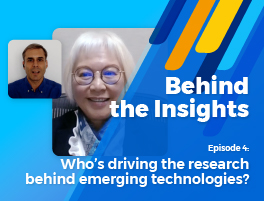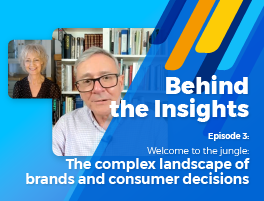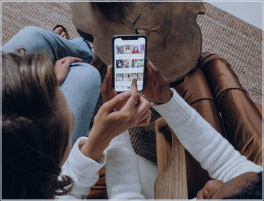Behind the Insights season 2 episode 2
Why online qual is taking over
This is Behind the Insights, a vodcast series by MetrixLab. We talk to experts from all over the world to find out what’s really driving today’s hottest topics in insights.
In this episode, join MetrixLab SVP Senior Client Director, Gavin Sugden, and Beam Suntory Global Insight Director, Paul Thomas, as they share a case study of the rise of online qualitative solutions (spoiler alert: This episode features product placement of MetrixLab’s Immerse digital qual platform!).
Check it out and stay tuned for more episodes every month!
Or if you prefer, read the full transcript below.
Intro: Welcome back to Behind the Insights, a vodcast Series by MetrixLab. We talk to experts from all over the world to find out what’s really driving today’s hottest topics in insights.
Gavin: Hi everyone. So my name is Gavin Sugden and I’m a senior client director at MetrixLab and I’m really pleased today to have Paul Thomas here for the discussion about the merits of digital qual research.
Paul: Thank you, Gavin. Yeah, hello, my name’s Paul. I’m one of the Global Insight directors at Beam Suntory. Lucky enough to look after insights for a wonderful portfolio of brands like Jim Beam, House of Suntory Whiskey Maker’s Mark, Sipsmith Gin, Roku Gin. I’m getting thirsty even thinking about it.
Gavin: We’ve known each other for a while now and both worked client side, agency side, and then even overlapping one agency together. And in that time, what are the biggest developments that you’ve seen in the research industry?
Paul: Yeah, thanks a lot Gavin. I mean, I think the big one is the changing role of insights and insight functions in particular. When we started, we were data providers, lots of charts, lots of numbers. But now we’re much more internal consultants or we’re salespeople, and our ability to sell a story is often just as important as the numbers behind it.
The changing research triangle, we always used to say, “It’s about speed versus cost versus quality,” whereas with new advances, it actually means you can have all three.
So now we’ll talk about today’s biggest developments. The role of automated or self-serve research sitting within clients themselves rather than relying on agencies, the growth, the adoption of tech, using AI seamlessly within processes. None of us have been sacked. None of us have been replaced by robots yet as well, which is a bonus. And then finally, the real growth of online qual.
I think it started with online communities probably seven or eight years ago, which became more prevalent. But I think now more and more people and insight practitioners are willing and happy to use online qual and try to understand its benefits over traditional qual.
Gavin: I remember a time when there was a reluctance to move from face-to-face qual to online qual. And the kind of notion that it’s only really for when you’re targeting hard to reach respondents and I mean it’s fun isn’t it, how far things have come utilizing online discussions and pop-up communities in so many diverse ways.
Paul: Well, then, that’s right. I mean, I hate to use the C word in any interview, but Covid has definitely expedited things for a couple of years. We all had to pivot. There was no qualitative research whatsoever. Or at the very least, it was awkward, it was difficult, and it didn’t feel natural.
So I think that forced a lot of insight practitioners to accept that online qual had a role. And the way I look at it is that it’s another tool in our tool belt, another weapon in our arsenal. It shouldn’t replace offline qual, but it has a different role and a different purpose.
You know, there’s huge benefits in terms of speed and cost, the number of people you can talk to simultaneously, flexibility, the fact you can quickly make live changes to a discussion guide, follow up with those questions.
That doesn’t mean it’s suitable for everything. There are still some really in-depth topics like evaluating scripts or storyboards or some really personal topics where you need that kind of one-on-one relationship.
For me, it’s a little bit like where my career started. There was that big battle between online quant and offline quant, which is better, which is worse. And I think the answer for qual is exactly the same. They’re both really useful tools, provided you understand the right use cases for each.
Gavin: Absolutely. I know you’re fond of our online discussion tool Immerse. For those who don’t know, it’s a quali-quant discussion tool, with large sample sizes that all takes place in a live session, which means clients can view discussions in real time. And, you know, it really gives them a sense of the findings as they emerge throughout the discussion. And the clever part is really where the AI comes in within the tool. It allows people to vote on answers that have been given by other respondents and which ones they agree with most. And you start to get that really qualitative feedback as well as consensus across the group for some themes, ideas and other people’s input.
So you’ve actually worked with us using the tool in your current and previous roles as well. What do you particularly like about it?
Paul: I think it’s a really great tool for a number of reasons. And I think I’ll highlight three of them here. First of all, the number of consumers you can talk to. You’re not having that classic “Oh my God, I’ve only got this much budget. I can maybe squeeze in four focus groups,” where two of the respondents don’t turn up, two of them don’t say anything, and two of them are drunk. You don’t have that issue anymore.
Secondly, it’s the ability for you and your stakeholders to watch it live, in the comfort of your own homes or in the comfort of your office.
And then finally, especially in multi-country studies, the built-in Google translate in the tool. It means that you’re not relying on the cost, and often the complexity, of simultaneous translation. It gives you enough of a flavor to be able to see what’s going on and understand those markets.
So like I mentioned the number of people, so I recently ran a piece of work with you Gavin which was 70 consumers. So as well as getting those qualitative responses to what we showed them using the AI methodology that you discussed, they could also vote. Meaning that on a lot of the key questions we were able to see, even if it was directional quali-quant, n=70.
We started to have some numbers and some confidence and were able to call out, in our final report to stakeholders, where there were significant differences.
So lots of rich qual but backed up by that sort of preference and voting and then yeah the ability to see it live.
I remember the old days of sitting behind a dark glass, your marketing director was writing her emails. You were on your third bottle of wine. No one was actually paying attention to the research. Now, via Teams or other platforms, it allows you and your colleagues to watch discussions live, to discuss in a separate chat room, to throw extra questions to the moderator. And actually, in this example, in another piece I did with an old company, it allows you to pretty much have the answer of what you’re going to do next before the session is even finished. Which compared to the old days of six focus groups and waiting a month for the report to be written is really powerful. I think it also has great uses for pack tests, concept tests, and advertising tests. I think provided you’re clear on what you want from the study, you will be in great shape with this tool.
Gavin: I think that’s absolutely right. You know, the fact that you can have the Teams chat while it’s happening, you can kind of discuss what’s emerging. And as you said earlier, you can actually tweak the discussion and add questions on the fly. So, it’s great when people say “Oh, what do they mean by that?” And you can just say that “No worries! We can probe a bit further on that point.”
And I think for that reason, it’s a really versatile tool. We found that clients are using it for pack testing, for advertising, pre-testing and general understanding projects as well.
And I think it’s fair to say that the most recent project that we worked on with you ticked a lot of those boxes.
Paul: Yeah, I think that’s absolutely right. So we as a company were exploring an opportunity
in the sort of ready to drink space. And there were some really key and important questions asked from our board members who needed convincing about the right path to take with this opportunity. And this was one of those examples where quick and dirty would not do it. We couldn’t really go to our chief strategy officer with anecdotal evidence. So we needed something that hit the timeline, but it was also robust and something that was believable. So it wasn’t quick and dirty, it was quick and great. And so we wanted as a business to quickly gauge how excited consumers would be by this proposition to help inform that business decision.
Gavin: Yeah. That’s great. It was really, really nice to kind of have a specific challenge that this really fit the bill for. But as I understand, you also did some quant research alongside. So how did Immerse help specifically on this project?
Paul: No, that’s great. You know, we live in a world where quick turnaround quant is also available, which is wonderful. But that quick turnaround quant very rarely gives you much of the “why”. It gives you benchmarks, it gives you composite scores, etc. So what we were able to do is, based on the learnings of that quant, design a discussion guide in collaboration with the team at MetrixLab to help answer some of those questions.
So why the proposition was or wasn’t relevant? Which important occasions they think they might use it for?
Which drinks or the products they think they have it instead of or with. And that really helped us get to one key insight, one amongst many, but the really key one was the understanding that however much consumers liked this particular concept, the competitive set they saw it in and the occasion they could imagine using it in was a stark contrast with the price point of this product. And we wouldn’t have been able to get to that level of insight from the quant. And that information was vital in decision making for us.
Gavin: That’s great. And that that decision making specifically was to help the business with a go/no go decision.
Paul: Yeah, that’s exactly right. I mean, because a lot of people, right up to the board members were watching the group live with me. We were facilitating a conversation in an adjacent chat room. We were able to air our grievances, answer our questions and really quickly move to a decision.
Anyone who’s worked client side knows that the gap between a research debrief and a decision could be months. We were able to do it within a handful of days. And I just wanted to quote one of the stakeholders who joined on that call. They said “Thank you for such a good experience with the tool and the fabulous report we got afterwards. It was really impressive in terms of redefining agility with rigor.” And that’s not me. That’s one of my colleagues. So that gives you an indication of how useful it was.
Gavin: Well, it’s great to hear. And, you know, thanks for sharing. It’s been a great discussion. Thank you. We look forward to the next one.
Paul: Yeah, definitely. It’s such a rich tool and it’s one I’m delighted to have in my tool kit. So thanks a lot, Gavin.
Gavin: Thanks for your time Paul.

